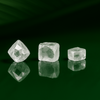
What is a High Pressure High Temperature (HPHT) Diamond?
Shop Lab-Grown Diamond Jewelry – Sale On Now!
In recent years, the world of gemstones has experienced a technological revolution, with lab created Diamond becoming increasingly popular for their beauty, ethical sourcing, and affordability. Among these innovations, the High Pressure High Temperature (HPHT) method stands out as one of the earliest and most fascinating techniques used to create or enhance diamonds in laboratory conditions. But what exactly is an HPHT diamond, and how does it differ from other Diamond or even natural diamonds?
This blog explores the science behind HPHT, how it replicates the natural forces deep within the Earth, and what it means for consumers looking for brilliance without compromise. Understanding HPHT diamonds can help you make more informed and confident decisions whether you're a curious buyer or a gem enthusiast.
But HPHT isn’t only about creating diamonds from scratch, it’s also use to enhance and improve the colour of both natural and lab grown diamonds, often making them whiter and more desirable for jewellery purposes. In fact, HPHT diamonds are so convincing that even experienced gemologists rely on specialised equipment to tell them apart from natural Diamond.
What is HPHT Diamond?

The HPHT process begins with a diamond seed, usually a small sliver of carbon. This seed is place in a specially design press and surround by pure carbon material (often graphite). Under extreme conditions, temperatures of around 1,300 to 1,600°C and pressures of 5 to 6 GPa (gigapascals) the carbon melts and begins to form around the seed, crystallising into a full diamond over several days or weeks.
This method mimics nature, but completes the growth process in a controlled laboratory environment, making it possible to produce high-quality diamonds with fewer ethical or environmental concerns.
Not all HPHT diamonds are grown from scratch. Many are natural diamonds that undergo HPHT treatment to improve their colour and clarity. Some diamonds mined from the Earth contain tints of brown or yellow due to impurities or internal strain. The HPHT process can alter the atomic structure or remove these impurities, effectively transforming a lower-grade diamond into a whiter, more desirable gem often with a D, E, or F colour rating.
How HPHT Diamond Are Made
Creating an HPHT diamond involves replicating the extreme temperature and pressure conditions under which natural diamonds form deep within the Earth. In a laboratory setting, this complex process can be carefully control, allowing for consistent production of gem-quality diamonds with fewer flaws and more ethical traceability.

Preparing the Diamond Seed
The process begins with a tiny diamond seed usually a flat sliver of an existing diamond. This acts as the foundation upon which the new crystal will grow.
Placing the Seed in a Carbon Source
The diamond seed is place in a container fill with a carbon-rich source, typically graphite. This container also contains a metal catalyst (like iron, nickel, or cobalt) to help the carbon melt and crystallise more efficiently.
Applying High Pressure and High Temperature
The entire assembly is then place inside a powerful HPHT press. There are three main types of presses use:
- Belt Press – the original, now mainly used for industrial-grade diamonds
- Cubic Press – widely used in commercial production
- BARS Press (Split-Sphere) – considered the most efficient for high-quality diamonds
Inside the press, extreme conditions are creat:
- Temperature: 1,300°C to 1,600°C
- Pressure: 5 to 6 gigapascals (GPa), equivalent to over 70,000 times atmospheric pressure
- Under these conditions, the carbon melts and begins to crystallise around the diamond seed.
Diamond Growth
Over several days to weeks, carbon atoms arrange themselves into the diamond crystal structure, layer by layer. The size, clarity, and colour of the resulting diamond depen on the purity of the materials use and how tightly the process is control.
Cooling and Extraction
Once the diamond reaches the desired size, the temperature and pressure are gradually reduce. The new diamond is then carefully extract from the press and cleaned to remove any metal residue or impurities.
Cutting, Polishing & Grading
The rough HPHT diamond is cut and polish, just like a natural diamond, to bring out its full brilliance and sparkle. Afterwards, it is grade by gemological labs such as GIA or IGI, based on the 4Cs: Cut, Clarity, Colour, and Carat weight.
HPHT vs CVD Diamond
When it comes to lab grown diamonds, HPHT (High Pressure High Temperature) and CVD (Chemical Vapour Deposition) are the two main methods use. While both produce real diamonds with the same chemical composition as natural Diamond, they differ significantly in how they are made and in the qualities of the final gemstone.
- HPHT diamonds may require minimal treatment, particularly if colour quality is high from the start.
- CVD diamonds often undergo HPHT treatment after growth to improve colour and remove brownish hues caused by internal defects.
Both HPHT and CVD diamonds require specialised equipment for proper identification, especially since they’re chemically identical to mined diamonds. However:
- HPHT diamonds may show metallic inclusions under magnification.
- CVD diamonds can exhibit grain patterns or strain under polarised light.
| Feature | HPHT Diamond | CVD Diamond |
|---|---|---|
| Full Form | High Pressure High Temperature | Chemical Vapour Deposition |
| Growth Method | Mimics Earth’s mantle using high pressure and temperature | Grows layer by layer in a carbon-rich gas chamber |
| Temperature Required | 1300°C – 1600°C | 700°C – 900°C |
| Pressure Required | 5 – 6 GPa (extremely high) | Low pressure |
| Growth Shape | Cubic or octahedral crystals | Flat, tabular crystals |
| Growth Time | Several days to a few weeks | 1–2 weeks depending on size and quality |
| Metal Inclusions | May have metallic inclusions from catalysts | Typically no metallic inclusions |
| Colour Quality | Often better naturally; less post-treatment needed | May appear brownish; often improved via HPHT after-growth |
| Clarity | Good, but inclusions can be metallic | Generally better; may have strain lines (graining) |
| Post-Treatment | Usually minimal | Often requires HPHT treatment to improve colour |
Advantages of HPHT Diamond
HPHT diamonds are known for their naturally high colour grades, often falling in the D to F range, which is considere colourless and premium. Unlike CVD diamonds, which often need post-treatment to remove brownish tints, HPHT diamonds usually come out of the growth process with bright, white colour. This makes them a preferred choice for consumers seeking a naturally brilliant appearance without additional enhancement.
The HPHT method closely replicates the conditions deep inside the Earth’s mantle, using extremely high pressure and temperature to grow the stone. This means HPHT diamonds are structurally and chemically similar to mined diamonds, offering a more authentic experience to those who appreciate natural growth characteristics in lab created Diamond.
When producing small diamonds, such as melee Diamond used in pavé or side settings, HPHT is more economical than CVD. The faster growth rate and high output make HPHT ideal for creating large batches of small, high-quality diamonds at a lower cost, a benefit passed on to both retailers and customers. CVD diamonds sometimes exhibit visible strain lines or graining when examined under magnification.
HPHT technology can be use to create or enhance colour diamonds, producing stunning shades like blue, pink, yellow, and green. This makes HPHT ideal not only for white diamonds but also for customers looking for vibrant, rare-looking fancy-colour options at an accessible price point.
Are HPHT Diamond Real?
Yes, HPHT Diamond are real gemstones — they are chemically, physically, and optically identical to natural diamonds. The key difference lies not in what they are make of, but in how they are creat.
HPHT (High Pressure High Temperature) Diamond are produce in a laboratory under conditions that mimic the natural environment of the Earth’s mantle, where natural diamonds form. These lab grown Diamond are made entirely of carbon atoms arrange in a crystal structure just like mine diamonds. This means they have the same hardness (10 on the Mohs scale), sparkle, brilliance, and durability.
Scientifically Real
- Composition: 100% crystalline carbon (just like natural Diamond )
- Appearance: Identical to natural rocks to the naked eye
- Performance: Same hardness, brilliance, and fire
- Certification: Graded and certified by top labs like GIA, IGI, GCAL
- Recognised by the Jewellery Industry
HPHT Diamond are legally and commercially considered real diamonds, and they can even be laser-inscribe and certifiy by major gemological labs. The only distinction is that they are lab grown, not mined.
Buy a Lab Grown Diamond In Diamondrensu
If you're looking for a stunning, ethical, and affordable alternative to mined diamonds, Diamondrensu is the perfect place to shop. We specialise in high-quality lab grown diamonds, including HPHT and CVD options, available in a variety of shapes, sizes, and settings.
Each stone is crafted to deliver exceptional brilliance and beauty, and all our lab grown diamonds are certified by leading gemological labs. Whether you're celebrating an engagement, anniversary, or a special moment, Diamondrensu offers customisable jewellery that combines luxury with sustainability. Discover the future of fine jewellery with confidence at Diamondrensu.
Conclusion
High Pressure High Temperature (HPHT) Diamond Diamond are creat use advance technology that replicates the extreme conditions under which natural Diamond form beneath the Earth's surface. This method produces high-quality, durable, and brilliant Diamond that are virtually indistinguishable from mined ones.
Whether you're choosing an HPHT or a CVD stone, both offer excellent alternatives to natural Diamond with their own unique characteristics. HPHT stands out for its natural-looking colour and clarity, often requiring minimal post-treatment. Understanding these differences helps buyers make informed choices based on quality, budget, and personal preference.
FAQS
What is a high temperature high pressure diamond?
A complex method is also use to make high-pressure, high-temperature diamonds in a lab. In the HPHT process, a very small diamond seed (which can be natural or man-made) is put in an area with very high temperatures (up to 2,200 degrees Celsius!) and pressures (1.5 million pounds per square inch!).
What is the high pressure high temperature Hpht method?
There is a process call high pressure high temperature (HPHT) that makes single crystal diamond material. The starting material is usually a seed pad that the seeds are press into so that the seed's growth surface is roughly on the seed pad's surface.
Which is better CVD or Hpht?
CVD labgrown diamonds are a great choice if you want a diamond that is very clear and has few flaws. These are great for diamond rings and other high-end jewellery. HPHT diamonds are better for you if you like diamonds with bright colours or a natural growth process.
Why is HPHt more expensive?
Cost and Production: Because they have to be made under complicate, high-pressure conditions, HPHT diamonds tend to be more expensive. CVD diamonds, on the other hand, are usually less expensive and can be made more quickly.
Leave a comment
Please note, comments must be approved before they are published.









